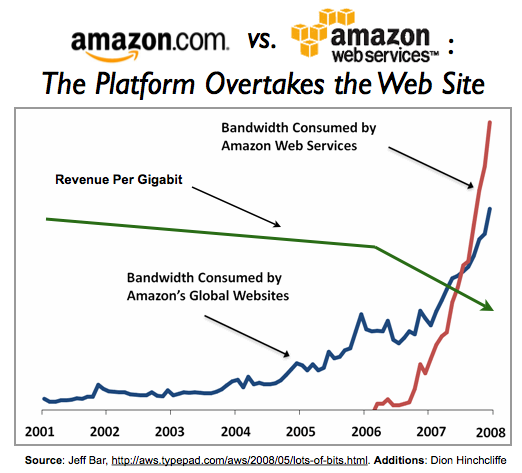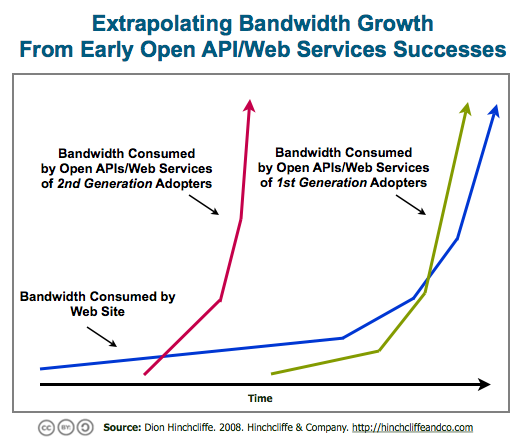A few days ago Amazon Web Services evangelist Jeff Barr released a graph (Figure 1 below) showing the growth of the bandwidth used by their global Web sites versus the bandwidth being consumed by their Web services. It’s eye opening because of the dramatic growth in bandwidth being consumed by their customers via their various non-visual, data-only Web services. The adoption of Amazon’s Web services is currently driving more network activity than everything Amazon does through their traditional Web sites. This is one of the key lessons of the 2.0 era: that the ultimate end-game generally boils down whoever has the deepest and most potent network effect, which are more pronounced when you’re data and software is being used from many other Web apps, instead of just your own.
The graph below clearly shows that Amazon has the hockey stick growth that generally signifies a powerful, deep seated uptake by 3rd party platform users. It also underscores the exponential results that comes from leveraging the intrinsic nature of open networks like the World-Wide Web to enable rapid growth. This is spreading Amazon’s platform to the far corners of the Internet in the way that Microsoft and IBM did so successfully with their own software platforms a generation ago, albeit in offline form.

Figure 1: Amazon’s open Web APIs now consume more bandwidth than all their sites combined
But what’s also interesting is that it’s taken nearly eight years for this result to occur for Amazon. Amazon was a first generation adopter of Web services and it was almost certainly the biggest pioneer as well. They offered Web services many years after their initial retail site launched and it’s achieved much of its success because of the early years Amazon spent driving economies of scale and inefficiencies out of their operations and then flipped that expertise into cost-effective open Web services offered to their already vast customer base.
Amazon’s early retail success in this way brings up a common question I get in my discussions with people trying to create competitive online products today. The question is: “Was Amazon unique because of it’s unusually dominant industry lead early in the history of the Web? Or is this this kind of growth a common effect for those that open up their platforms online to the Global SOA?”
What is an open API? Read about the motivations and techniques for adding open Web APIs to a site.
The good news for startups is that the answer seems to be no, Amazon is not unique in their success of their APIs. Certainly eBay has achieved a large measure of success with its open APIs, with over 60K registered developers and a large amount of API use. Salesforce too has been relatively successful with their open platform, and Google has as well with it’s increasingly robust set of API offerings.
But these are all larger, established Internet firms. How much can an API offering help a startup drive its network effect and platform adoption in the marketplace? The success of newer Web applications like Facebook, Twitter, and Friendfeed, which can be attributed to their success via the thousands of apps built for Facebook and dozens of applications for Twitter, which all capitalize on open APIs they offer (and indeed, are almost impossible without them) and drive the adoption of these apps.

Figure 2: As new sites offer APIs closer to initial launch, stronger network effects can form earlier
Twitter is believed to have 10 times the use through its API than through it’s Web user interface and this is likely contributing to their highly publicized downtime lately as they attempt to struggle with fast growth. The Web services approach completely changes where the focus of product design is, from the human/machine interface to the machine/machine interface. This can be significant challenge for those who come from the traditional Web design world, where user interfaces where all that mattered. The Web industry is changing rapidly in the face of these trends and building open platforms that are used from across the Web is the name of the game now instead of simple, point Web sites.
Sidebar: An approach called Web-Oriented Architecture (WOA) is an emerging best practice method for turning next-generation Web 2.0 applications into platforms.
The fast growth of newer Web platforms is key to adoption these days and most new entries in the marketplace have at least an RSS feed but usually much more as it becomes necessary to get developer adoption and 3rd party applications to drive traffic growth and adoption. Big issues still abound around monetization strategies for Web APIs and the rapidly emerging mashup industry, but Amazon too has shown that it can be an entire line of business, even if the margins appear to be much smaller: despite enormous bandwidth growth, revenue per gigabit is beieved to be much smaller with Web services, certain to be of much interest as new Web apps get investment and go to market. I’ll explore how this is likely to play out over the next few years as Web sevices industry and cloud computing and Platform-as-a-Service (PaaS) matures and evolves.
What issues are you seeing with offering open APIs for your Web site or application?
